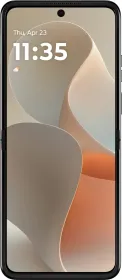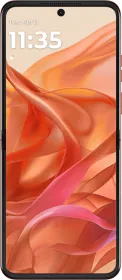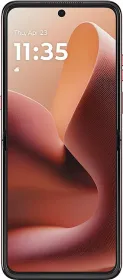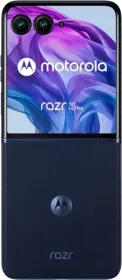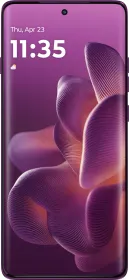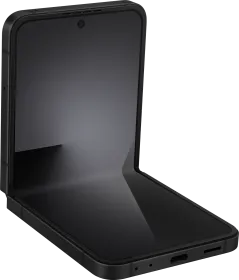The Motorola Razr 60 tries to bring the nostalgic flip phone experience to the masses with a so-called “affordable” price tag of ₹49,999. It features a foldable design, a 6.9-inch pOLED inner display, and Moto AI 2.0 features, and some questionable specs.
Yes, beneath the shiny exterior lies a litany of compromises that make it an almost impossible sell in 2025. From an underpowered chipset to poor camera processing and buggy software, the Razr 60 stumbles everywhere. After testing its performance, cameras, battery, and more, here’s what we found.
Motorola Razr 60 Price & Availability
The Motorola Razr 60 is available in three Pantone-certified finishes: Pearl Acetate Marble, Leather, and Nylon. It comes in one variant:
- 8GB + 256GB: ₹49,999
Available via Flipkart, Motorola’s official website, and select retail stores in India, with sales starting June 4, 2025.
Pros
- Compact foldable design
- 6.9-inch pOLED inner display with 120 Hz
- Decent battery life for light use
- IP48 water and dust resistance
- Gesture-based camera controls
Cons
- Underpowered Dimensity 7400X chipset
- Poor camera processing with hazy, soft images
- Outdated Rec601 video recording
- No Netflix HDR support
- Slow UFS 2.2 storage and LPDDR4X RAM
- Buggy, unoptimized software
- Visible screen crease and durability concerns
- Mediocre 33W charging
- Subpar haptics
Motorola Razr 60 Specifications
- Display: 6.9-inch pOLED, Full HD+ (1080 x 2640), 120 Hz, HDR10+, 3000 Nits peak, Ultra-Thin Glass; 3.6-inch pOLED outer display, 1056 x 1066, 90 Hz, 1700 Nits
- SoC: MediaTek Dimensity 7400X (4nm)
- RAM: 8 GB LPDDR4X
- Storage: 256 GB UFS 2.2
- Main Camera: 50 MP, f/1.8, 25mm, 1/1.95-inch, AF, OIS, 4K30
- Ultra-wide Camera: 13 MP, f/2.2, 13mm, 1/3-inch, AF, 4K30
- Front Camera: 32 MP, f/2.4, 25mm, 1/3.1-inch, 4K30
- Speakers: Stereo with Dolby Atmos
- Battery and Charging: 4,500 mAh, 33W wired, 15W wireless
- IP Rating: IP48
- Connectivity: 5G (16 bands), Wi-Fi 6, Bluetooth 5.3, USB-C (2.0), NFC
- Biometrics: Side-mounted fingerprint, 2D face unlock
- Weight and Dimensions: 186g, 7.25 mm (unfolded), 15.9mm (folded)
- Build: Aluminum frame, Gorilla Glass Victus back, titanium hinge
Motorola Razr 60 Review: Unboxing

The Motorola Razr 60 arrives in a compact box with:
- Motorola Razr 60
- 33W Turbo Charger
- USB-A to USB-C cable
- Hard plastic case (white)
- SIM ejector tool
- Paperwork
No earphones or screen protector are included, which is disappointing for a ₹50,000 phone. The included case is a nice touch but feels flimsy.
Motorola Razr 60 Review: Design and Build

The Razr 60’s flip phone design is its biggest draw, folding neatly into a pocketable square. At 186 grams and 7.25 mm thick when unfolded, it’s lightweight and sleek. The aluminum frame and Gorilla Glass Victus back give it a premium look, while the titanium hinge is SGS-certified for 500,000 folds.

However, the foldable display’s crease is glaringly visible and worsens with use, detracting from the premium feel. The IP48 rating offers decent water and dust resistance.
Durability is a concern, as the ultra-thin glass is prone to scratches, and the hinge feels less robust than other foldables like the Samsung Galaxy Z Flip5 or Flip6. For a foldable, these compromises sting at this price.
Motorola Razr 60 Review: Display

The 6.9-inch pOLED inner display offers FHD+ resolution, a 120 Hz refresh rate, and HDR10+ support. Colors are vibrant, but the 3000-Nit peak brightness is just on paper. The actual HBM brightness is much lower but there are no issues with outdoor use. The 3.6-inch outer display (90 Hz, 1700 Nits peak) is functional for quick tasks like notifications or selfies, reducing the need to unfold the phone.

Sadly, the lack of Netflix HDR support is a major miss for a foldable AMOLED touted for media consumption. Auto-brightness adjustments are sluggish and need some work. Hopefully, Motorola addresses this in a future update. Overall, it’s a decent display, but not a standout.
Motorola Razr 60 Review: Speakers and Haptics

The stereo speakers with Dolby Atmos deliver loud, clear audio but lack bass depth, making them average for media. Haptics are a weak point, with mushy, inconsistent vibrations that feel cheap compared to slab phones in this price range. Typing or navigating feels unsatisfying, undermining the premium foldable experience.
Motorola Razr 60 Review: Software

Running Android 15 with Hello UI, the Razr 60’s software isn’t what you’d expect. Bloatware, including ad-ridden apps like the Weather app, clutters the experience. Moto AI 2.0 features (e.g., Image Studio, Playlist Studio) are poorly optimized, with the universal AI search frequently crashing. The dedicated Moto AI button is nice but non-remappable, limiting its utility.
Motorola promises three years of OS updates and four years of security patches, but its track record isn’t exactly great—updates are slow, buggy, and often introduce new issues. Software stutters and app crashes are common, exacerbated by the weak Dimensity 7400X. Compared to Samsung’s polished One UI, Hello UI feels half-baked.
Motorola Razr 60 Review: Biometrics

The side-mounted fingerprint scanner is fast and reliable, though its placement is awkward when the phone is folded. The 2D face unlock struggles in low light and isn’t secure. Biometrics are functional but unremarkable.
Motorola Razr 60 Review: Performance
Powered by the MediaTek Dimensity 7400X (4nm), with 8 GB LPDDR4X RAM and 256 GB UFS 2.2 storage, the Razr 60 is woefully underpowered for ₹50,000. The chipset, a slightly tweaked Dimensity 7300, is better suited to ₹15,000 phones. It scores just 574,918 on AnTuTu and 1,061/2,800 on Geekbench 6 (single/multi-core), trailing all competitors.
The Geekbench 6 GPU scores aren’t impressive either. It scores a mere 3,183 in OpenCL GPU, which is not even close to the scores that you get with phones in the same price segment. And as expected, the storage scores are also low at 51,076, with sequential read and write speeds hitting 1002 MB/s and 672 MB/s, respectively.

Gaming and Daily Tasks
Daily tasks like browsing or messaging are fine but do suffer from frequent stutters, with frequent app reloads due to poor RAM management. Casual gaming (e.g., BGMI at 60 FPS) is possible but marred by frame drops and overheating (up to 48°C). The outdated UFS 2.2 storage slows app launches and photo saving, making the experience frustratingly sluggish.
Synthetic Benchmarks
| Benchmark | Motorola Razr 60 (Dimensity 7400X) |
| AnTuTu 10 | 574,918 |
| Geekbench 6 | 1,061/2,800 |
| Geekbench 6 OpenCL | 3,183 |
| AnTuTu storage test | 51,076 |
Motorola Razr 60 Review: Cameras

The Razr 60’s camera system is a letdown. The 50 MP main camera (f/1.8, OIS) and 13 MP ultra-wide (f/2.2) produce hazy, soft images with inaccurate skin tones and poor edge detection. The slow shutter speed and laggy camera app make capturing moving subjects nearly impossible. Low-light shots are noisy and lack detail, with over-sharpening further degrading quality.









The 32 MP selfie camera is passable in good light but struggles with backlit scenes, adding an unnatural glow. Video recording, capped at 4K30, uses the outdated Rec601 color space, resulting in oversaturated, jittery footage with poor stabilization. The gesture-based controls (e.g., palm to start recording) are novel but unreliable.
Motorola Razr 60 Review: Battery Life and Charging

The 4,500 mAh battery lasts a full day for light users (5-6 hours screen-on time), thanks to the efficient outer display. However, heavy use (e.g., gaming, video) drains it faster, yielding just 4 hours. The 33W wired charging takes ~51 minutes for a full charge, slow compared to 65W+ on mid-range slab phones. The 15W wireless charging is a nice touch though.
Review Verdict: Should You Buy the Motorola Razr 60?
The Motorola Razr 60 banks on its flip phone design, but it’s a case of style over substance. The underpowered Dimensity 7400X, outdated UFS 2.2 storage, and buggy software make it a chore to use. The camera’s abysmal processing, lack of Netflix HDR, and visible screen crease further diminish its appeal. Add Motorola’s poor after-sales service and rapid value depreciation, and the Razr 60 is a risky buy at ₹49,999.
For the same price, slab phones like the iQOO 13, realme GT 7, OnePlus 13R, or older foldables like last year’s Samsung Galaxy Z Flip5 offer superior performance, cameras, and software. Unless you’re desperate for a budget foldable and can overlook its many flaws, steer clear of the Razr 60.

Smartprix ⭐ Rating: 6.35/10
- Design and Build: 7/10
- Display: 7/10
- Speakers: 6.3/10
- Software: 6/10
- Haptics: 7/10
- Biometrics: 6.9/10
- Performance: 5/10
- Cameras: 5.5/10
- Battery Life & Charging: 6.5/10
First reviewed in May 2025.















